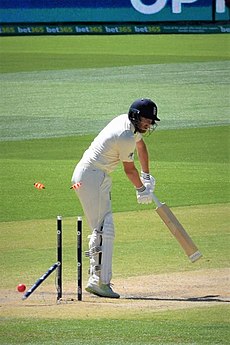Engineering:Stump microphone
A stump microphone, informally known as a stump mic, is a microphone embedded in a cricket stump. It was originally developed by Kerry Packer for World Series Cricket in the 1970s.[1] At first it was primarily for entertainment value: "television audiences could hear the rattle of stumps".[2]
Later, the technology became part of the Decision Review System; the microphone detects the sound of a batsman hitting the ball in order to determine whether he should be given out caught (or alternatively, not out leg before wicket). This technology is called Snickometer, with the later version being known as Real Time Snickometer (RTS). It was introduced at the 2007 World Cup for this purpose.[2] Audio analysis of the sound produced can distinguish between the "sharp sound from bat on ball" and the "muffled sound from bat or ball on pad".[3]
An important effect of stump microphones is that players are less likely to engage in sledging, although it is still done out of the microphone's range.[2] England coach Trevor Bayliss has expressed disapproval over sledging being caught on the stump mics, suggesting that sledging must be censored on television.[4] Conversely, England cricketer Moeen Ali suggests stump mics should be turned up, in order to deter players from sledging.[5] As of 2019, International Cricket Council guidelines say the volume of the stump microphones must be turned down when the ball is dead or not in play.[6]
References
- ↑ Proudman, Dan (10 June 2014). "Gary Gilmour: Charisma at the crease". The Newcastle Herald. Retrieved 11 June 2014.
- ↑ 2.0 2.1 2.2 Menon, Suresh (19 February 2019). "Stump microphones serve a purpose, but not the one you think". The Hindu. https://www.thehindu.com/sport/cricket/stump-microphones-serve-a-purpose-but-not-the-one-you-think/article26314617.ece.
- ↑ Kidger, Mark (2011). The Physics of Cricket: From Hotspot to Statistics. Nottingham University Press. p. 178. ISBN 9781904761921. https://books.google.com/books?id=sLSxAwAAQBAJ&pg=PA178. Retrieved 10 July 2022.
- ↑ "Escalating Ashes sledging should be censored on TV, England coach says" (in en-AU). ABC News. 2017-12-04. http://www.abc.net.au/news/2017-12-04/ashes-sledging-should-be-censored-on-tv-bayliss-says/9222352.
- ↑ "Turn up stump mics to curb sledging, says Moeen" (in en). https://www.channelnewsasia.com/news/sport/turn-up-stump-mics-to-curb-sledging--says-moeen-11245926.
- ↑ Ranjan, Amol (10 March 2019). "How Cricket Stump Mics Are Expanding the Private Into the Spectacle". The Wire. https://thewire.in/sport/how-cricket-stump-mics-are-expanding-the-private-into-the-spectacle.
 |


